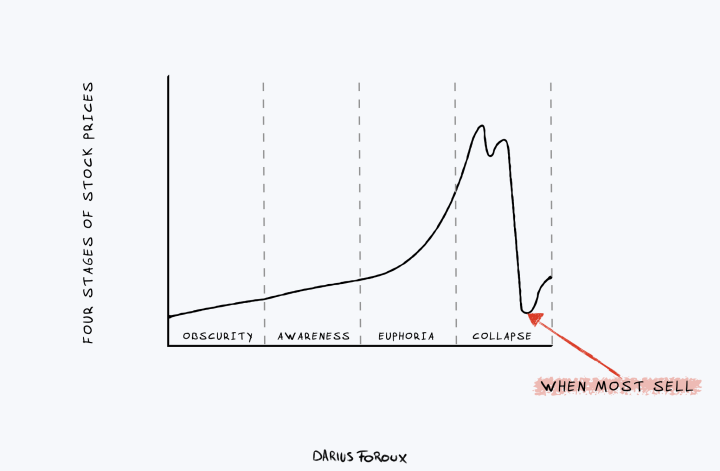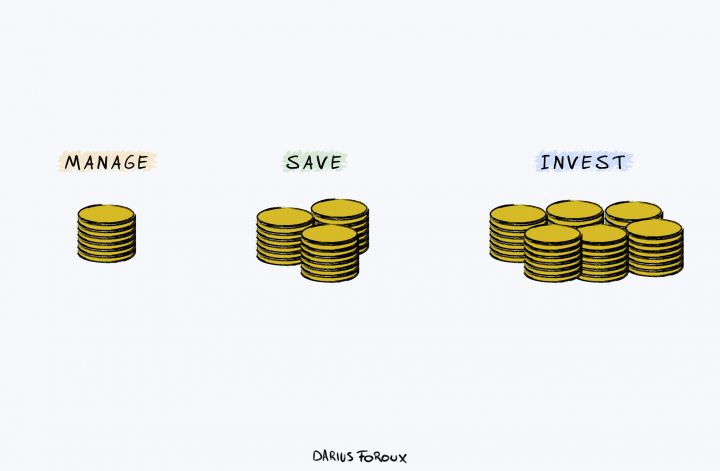If you sell your stocks now, you’re likely doing so at a loss.
In 2022, the S&P 500 closed down nearly 20%, its worst performance in 14 years. The technology index, Nasdaq 100, performed even worse at minus 28% on the year.
By the end of 2022, I started seeing more reports in the media about how individual investors stopped investing. Trading activity and net inflows started to go down.
In a WSJ article, one of those individual traders said:1Source: The Wall Street Journal
“It was fun for a while, things were going up and down pretty fast.”
The latter part is when people start to lose interest. Here are the different stages of stock prices:

During the Collapse Stage, people usually get out because every investor has a breaking point.
No investor can take the pain of loss forever
Most individual investors get excited about stocks at the end of the Awareness and beginning of the Euphoria stage. During that time you can’t make mistakes in public markets as long as you’re bullish.
Everything you buy goes up so you feel like a genius.
Then, the market starts crashing. And you’ve been conditioned to “buy the dip” so that’s what you do. You think the pullback is temporary.
“We’ll go back up soon. This stock will double in six months. Good buying opportunity.”
The stock keeps going down.
“Add more. If you liked the price before, you should love it now that it’s lower.”
The stock goes down harder.
(Silence)
“Uhm… What’s going on?”
Down, down, down. Negativity and bearishness are everywhere.
“Ok, that’s it. I’m out!”
Stocks go down a bit more but stabilize.
“Glad I dodged that bullet!”
Stocks start going up.
“Yeah right, I’ll wait until they go down again.”
Stocks keep going up.
“F#@K STOCKS.”
How to avoid selling your stocks at the bottom
I’ve experienced the above dialogue in my mind and in my wallet many times. The first time was in 2008 when the financial crisis happened.
Later, I tried my hand at trading stocks. And the same thing always happened to me.
Even if there’s no wide market crash, you can still get burned on individual stocks. My solution was to start viewing investing as an emotional pursuit.
I started applying the philosophy of Stoicism to my investing strategy. It’s the topic of my next book.
The key is to gain control of your emotions and pick an investing strategy you can stick with. Here are a few lessons I learned:
- Ignore financial media — The media always reports about current events. But the stock market is an organism that operates on its own set of rules. What most people misunderstand about financial media is that it only reports, it doesn’t explain. They might report that stocks are down but not why because no one knows why in real time. I still like to read and consume financial media outlets, but I don’t let them influence my decisions.
- Develop an investing strategy FOR LIFE — If you don’t have an investing strategy that you’re willing to stick to for the rest of your life, I wouldn’t bother investing at all. Financial markets are not like restaurants. You can’t try out different things because you will lose money. Investing is only successful if it’s boring and lacks variety. To succeed in the markets, pick one restaurant and go there until you retire.
- Live your life — John Bogle, the founder of Vanguard, and the person who popularized low-cost index funds believed you should never look at your stock portfolio. He said you should just invest every month and get on with your life. When you want to retire, open your account and enjoy the wealth you’ve accumulated over your career. I love Bogle, but I can’t do that as someone who’s OCD about his money. I usually take a look at my portfolio two or three times a month just to see what’s going on. Because I practice Stoicism, I don’t get swayed by my emotions. But still, I don’t recommend looking every day. Just live your life!
- Be content — Look, life isn’t necessarily better if you have a lot of money. It just makes life hard because when you upgrade your lifestyle; You can’t go back. It’s best to work yourself up to a lifestyle that’s good, but not too comfortable. And then be content with what you have. Save and invest your money, but say goodbye to that cash. You won’t need it for now anyway.
- Don’t hold the bag — If you do want to trade stocks, sell if you’re down 10%. It’s not worth it to hang on to a stock that goes down 80% or 90%. That’s just way too painful. In general, I don’t recommend trading stocks at all to most people. If a new bull market starts and the fed is starting to lower interest rates, go for it if you can be responsible. But just be honest. If you don’t have the character or self-control, stay away from trading. Become a long-term investor and enjoy the benefits of compounding.
If you want to avoid selling your stocks at the bottom, you need a combination of knowledge, self-control, and self-awareness.
That’s something you don’t develop within a day, month, or even a year. Give yourself time to develop your character and knowledge.
In time, I guarantee you will feel better about investing the more you learn about finance and about yourself.




